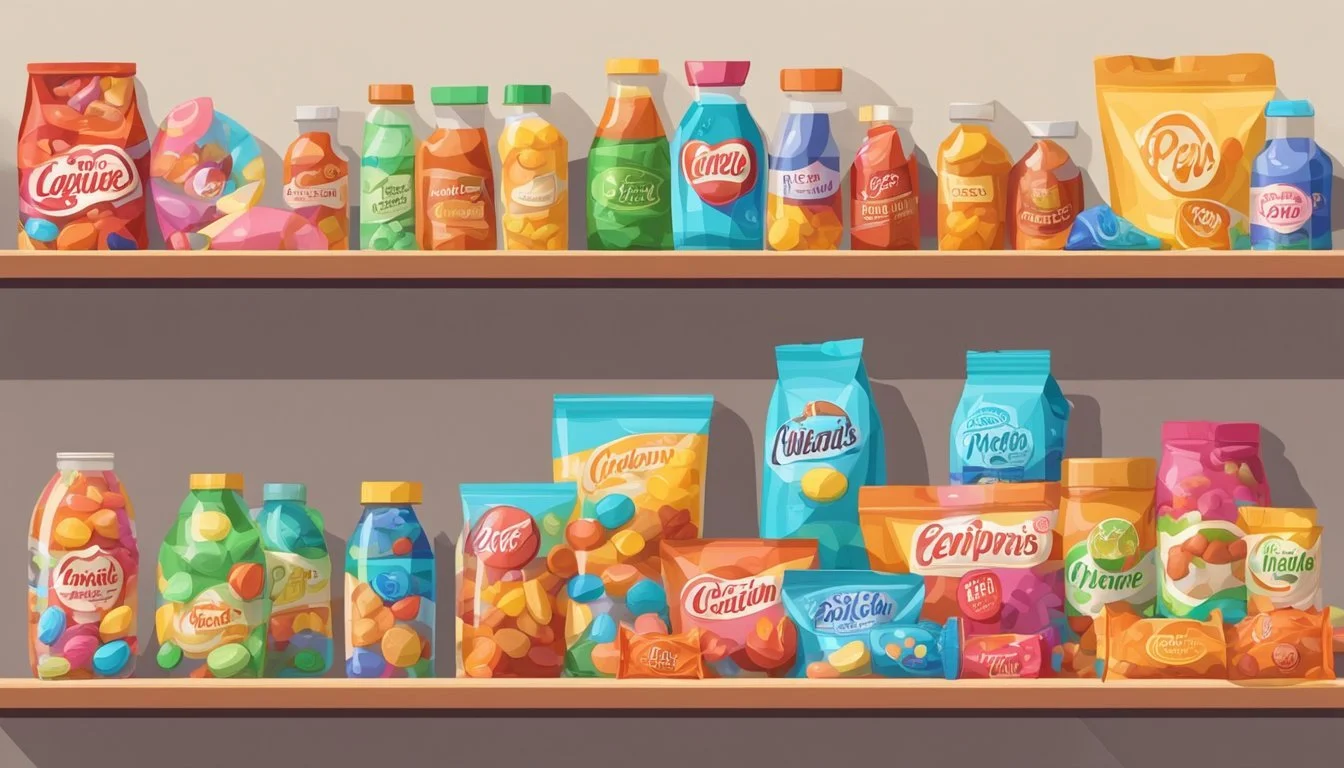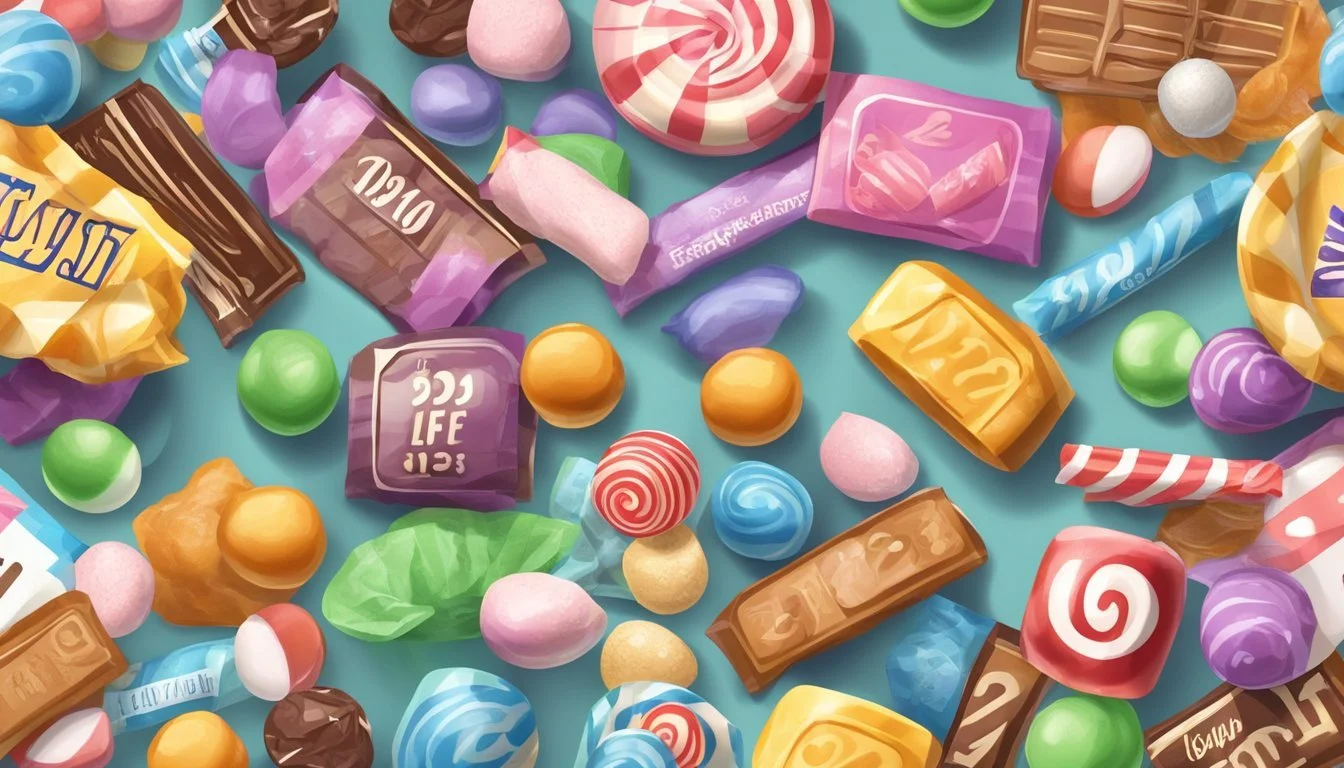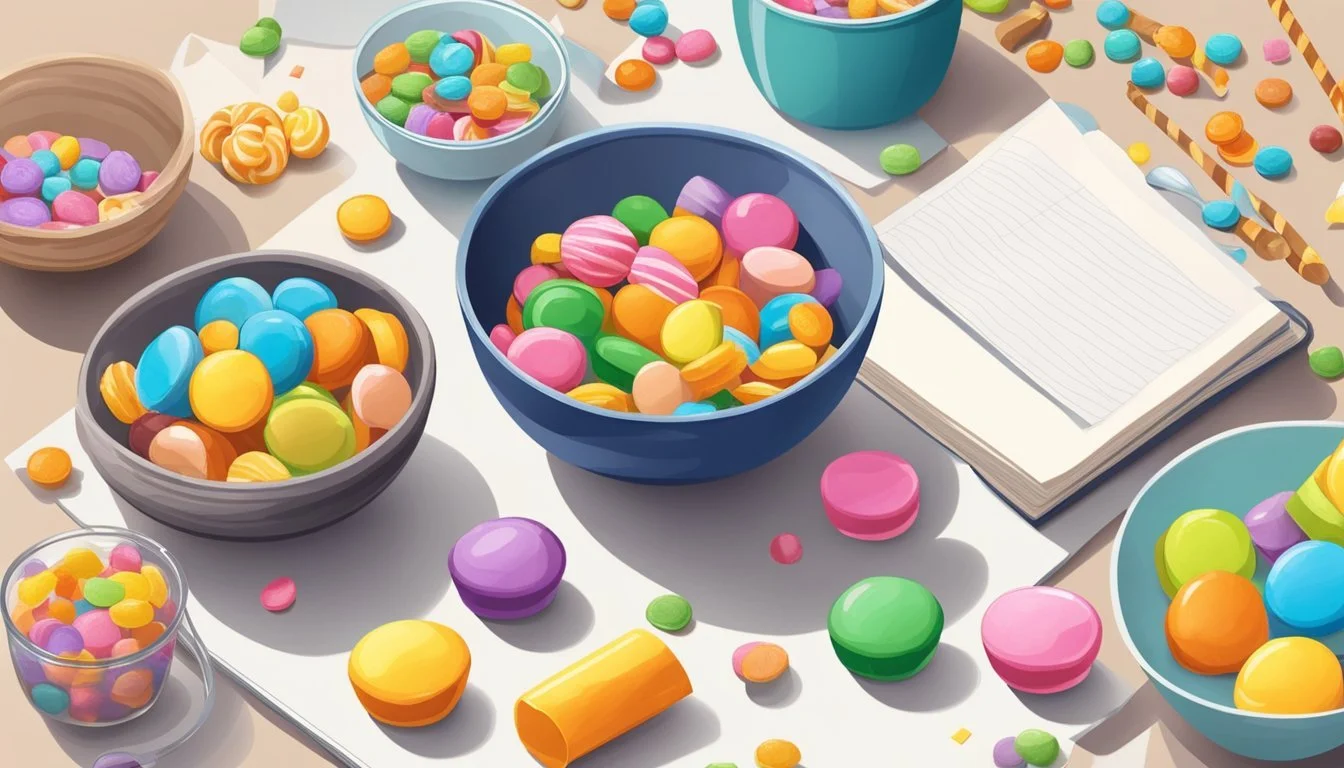How Long Does Candy Last?
Shelf Life and Storage Tips
Candy, a confection that delights people of all ages, has a varied shelf life depending on its type. For instance, gummy candies, often a favorite among sweet enthusiasts, generally remain in good condition for six months to a year if stored properly in a cool, dry place. The longevity of candy is influenced by factors such as ingredients, preservative usage, and exposure to elements like heat and moisture.
Chocolate (What wine goes well with chocolate?) lovers would be interested to know that dark chocolate holds its quality the longest, sustaining its taste for up to two years under ideal conditions. On the other hand, milk and white chocolates, which could be considered softer types of chocolate, typically have a shorter shelf life, ranging from eight to ten months. The presence of fillings or nuts in chocolate can also affect its durability.
Candy expiration dates, often marked as "Best By," signify the period within which the product retains peak quality. Beyond these dates, candy may lose some of its fresh taste but can often still be safe for consumption. While hard candies like those given out during Halloween may not always have individual expiration dates, they can last quite a while and their condition can be assessed by their appearance and texture.
Understanding Candy Types
Candies come in an array of types, each with distinct characteristics that influence their shelf life. Here is a breakdown of some common varieties:
Chocolate-Based Candies:
Milk Chocolate: Contains dairy, which shortens its shelf life compared to dark chocolate.
Dark Chocolate: Less milk content, potentially lasting longer.
White Chocolate: Has dairy and fat content, usually a shorter shelf life.
Sugar (how long does sugar last?) Candies:
Hard Candies: Low moisture content leads to a longer shelf life.
Chewy Candies: Include items like caramels and nougats; moisture and fat can reduce shelf life.
Gummy Candies and Jelly Beans: Generally last 6 months to a year if stored properly.
Lollipops: Similar to hard candies, longer shelf life due to low moisture.
Specialty Candies:
Sour Candy: The acidic content may influence how long they maintain quality.
Candies with Nuts or Peanut Butter (how long does peanut butter last?): High fat content can cause these to expire faster.
Storage conditions play a pivotal role in the longevity of candy. Keeping candy in a cool, dry place away from sunlight is typically advised to maximize shelf life. It's important for consumers to observe best-by dates provided by manufacturers, yet many types of candy may still be consumable past that point under the right conditions.
Factors Affecting Candy Shelf Life
Candy shelf life can vary widely based on several factors:
Type of Candy: Candies high in sugar and low in moisture, such as hard candies, tend to have a prolonged shelf life, as sugar acts as a natural preservative. In contrast, candies containing fat, like chocolate, or those with high moisture content, like gummies, may spoil more quickly.
Storage Conditions: Proper storage is crucial. Candies should be kept in a dry, cool environment. Extremes in temperature can lead to melting or sugar bloom in chocolates, where a white, powdery coating appears on the surface.
Humidity: High humidity levels can adversely affect candy by introducing moisture, leading to clumping or sugar crystallization.
Container: Storing candy in an airtight container can significantly extend its shelf life by protecting it from air and moisture. Inadequate sealing allows unwanted air to degrade the product faster.
Ingredients: Specific ingredients influence longevity. Candy with dairy or nuts may expire faster due to the fats which can turn rancid, while high-sugar, low-moisture candies like lollipops and hard candies last longer.
Remember to check manufacturer's expiration dates for better accuracy, as they take into account all ingredients and their interaction under specific storage instructions.
Shelf Life of Common Candies
The longevity of candy depends on its ingredients and storage conditions. Specific types of candies have differing shelf lives, greatly influenced by their sugar and moisture content.
Chocolate Candies
Dark Chocolate: Typically, dark chocolate can last up to two years when stored properly in a cool, dark place. Milk Chocolate and White Chocolate have a shorter shelf life, ranging from six months to a year.
Hard Candies
Hard candies and lollipops, due to their high sugar and low moisture content, can generally maintain their quality for a long period. They have a lasting power of about one to two years when kept in appropriate conditions away from moisture and heat.
Gummy and Chewy Candies
Gummy candies, including those that are sour flavored, usually have a shelf life of up to one year. Chewy candies, such as caramels and nougat, may have a relatively shorter shelf life due to their moisture and fat content.
Sugar Candies
Candy corn and jelly beans, which are primarily made from sugar, have a shelf life that can extend up to nine months. They should be stored in a cool, dry area to prevent them from hardening or becoming stale.
Storage Techniques for Optimal Freshness
Proper storage techniques are essential to preserve the freshness, flavor, and texture of candy. The following methods are recommended to ensure candies last as long as possible without losing quality.
Airtight Containers
Storing candy in airtight containers is crucial for maintaining its quality. Containers with tight-fitting lids keep out moisture and air, which can degrade candy over time. Glass jars or plastic containers with seals are ideal choices. For candies in their original packaging, it is beneficial to place them inside resealable bags before storing to add an extra layer of protection.
Refrigeration and Freezing
For certain types of candy, particularly chocolate or candies that contain dairy, refrigeration can help extend freshness. Store these candies in the refrigerator at 60-70°F (15-21°C) to maintain their texture and prevent melting. Freezing is also an option for long-term storage, although it is important to ensure that the candy is wrapped properly to prevent freezer burn and to thaw it correctly before consumption to avoid any loss of quality.
Dry and Cool Environments
Candy should be kept in a cool and dry place, away from direct sunlight and away from any sources of heat. Ideal temperatures range between 60-70°F (15-21°C). High humidity levels above 50% should be avoided as they can make candies soft and sticky. A pantry or cupboard often provides the dry, consistent environment needed to keep candy at its best.
Recognizing Spoilage and Expired Candy
When examining candy for spoilage, one should consider several key indicators. It is generally understood that candy does not expire in the same way that perishable foods do, but its quality can deteriorate over time. Here is how one can assess if candy is past its prime.
Visual Clues:
Mold: If there are signs of mold, the candy is not safe for consumption.
Discoloration: Any significant changes in color may indicate spoilage.
Texture Changes: Candy's texture often changes when it is no longer at its best quality.
Hard candies may become sticky or tacky.
Gummy candies that are usually soft may harden or become excessively chewy.
Taste and Flavor: The flavor profile of candy can change over time.
If the taste is off or has diminished significantly, the candy's quality has likely declined.
Expired candy may also have a stale or unusual flavor, which suggests it's past its best before the date.
Safety and Consumption: Though expired candy may not always be a safety hazard, one should be cautious.
Candy that has passed its best before the date may still be edible if there are no signs of spoilage.
However, the consumption of expired candy could potentially lead to food safety concerns if there is any indication of contamination.
One should always use their best judgment and err on the side of caution when deciding whether to consume expired candy.
Safety and Health Considerations
When considering the consumption of candy beyond its expiration date, one must assess the risks associated with spoilage and contamination, which have direct implications for safety and health.
Consuming Expired Candy
Expired candy, while not typically hazardous, can have a compromised quality and taste. However, one should be cautious, as certain ingredients in candy can deteriorate, potentially leading to spoilage. Chocolates, for instance, may develop a white coating known as bloom, caused by sugar or fat moving to the surface, which, while not harmful, indicates a decline in quality. Always inspect expired candy for:
Unusual odors
Discoloration
Changes in texture
Should one notice any of these signs, it's advisable to discard the candy to avoid any potential health risks.
Contamination Risks
The risk of contamination increases as candy packaging deteriorates over time. Candy can be exposed to bacteria, insects, or chemicals if the packaging is compromised or if stored improperly. Adhering to storage recommendations is key to minimizing this risk.
To avoid contamination, follow these storage guidelines:
Keep candy in a cool, dry place away from sunlight.
Ensure that candy is stored in airtight containers once opened.
Do not store candy near non-food chemicals or cleaning supplies.
Proper storage will help maintain the integrity of the candy, keeping it safe for consumption for as long as possible. If one suspects that contamination has occurred, the candy should be discarded to prevent any health complications.
Interpreting Labels and Expiration Dates
Understanding the specifics of label dates and what they imply for candy longevity is crucial for consumers to ensure they enjoy products at their best quality.
Expiration Date Significance
Expiration dates on candy are indicative of when a product is expected to potentially decline in its optimal quality and flavor, not necessarily its safety. These dates serve as a benchmark for retailers and consumers, but they don't mean that candy will be unsafe to eat immediately after the date has passed. In fact, candies can often be consumed well beyond their expiration date, although the quality may be reduced.
Best By vs Expiration Dates
The term Best By dates differ from expiration dates in that they suggest when the candy should be consumed to experience the peak quality. It's important to distinguish that Best By labels are not safety indicators but quality guides.
Label Type Meaning Expiration Marks the end of the estimated period for peak quality and freshness. Best By Indicates the timeframe in which the best flavor and texture are expected.
Candy expiration dates can be conservative, and many types of candy are still enjoyable past these dates, especially if they have been stored properly in a cool, dry place to prevent degradation.
Preserving Candy for Special Occasions
When storing candy for special events like Halloween or as gifts, ensuring freshness and flavor are paramount. The key lies in how one stores these treats, and certain techniques can ensure they remain as enjoyable as the moment they were received or purchased.
Best Practices for Long-Term Storage
The best way to store candy long-term involves sealing it away from air, light, and heat. Here is a quick guide:
Packaging: Use airtight containers to keep moisture and pests at bay. For extra protection, consider vacuum-sealing if available.
Environment: Keep the storage area cool, around 70 degrees, and dry to prevent melting or sugar bloom.
Candy Type: Some candies, like hard candies, are more suitable for long-term storage as they have a lower moisture content.
Inspection: Regularly check the candy for texture changes or flavor loss.
Table for Candy Types and Their Storage
Candy Type Storage Method Expected Shelf Life Chocolate Airtight container; cool, dark place six months to a year Gummy Seal tightly; store at room temperature up to one year Hard Candy Vacuum seal; store in a cool, dry place Check regularly for stickiness Jellied Candies Light-proof container; room temperature six to nine months
Candy as Treats and Gifts
When presenting candy as treats or gifts, the presentation is as important as the freshness.
Layering: For soft candies like fudge or toffees, layer with waxed paper to prevent sticking.
Containers: Choose festive, airtight containers that add to the appeal yet protect the candy inside.
Immediate Consumption: If the candy is meant to be eaten right away, decorative bags or boxes that aren't airtight are acceptable.
Labels: Include a note with the date of packaging and any storage instructions to help recipients maintain freshness.
Myths and Misconceptions About Candy Expiration
Many consumers misunderstand what candy expiration entails. A common misconception is that candy becomes harmful after the expiration date. However, the truth lies less in expiration and more in quality. Candy does not spoil like fresh produce or dairy, but its taste and texture may degrade over time.
Expiration dates on candy are often a Best if Used By indication rather than a strict expiry. This means that after this date, the candy's taste and quality may not be at its peak but it can still be safe to consume.
Here is a breakdown of the realities behind candy expiration:
Safety vs. Quality:
Expiration Date: Primarily about optimal taste, not safety.
Misconception: Past this date, candy is unsafe.
Reality: Candy can remain safe but may lose flavor or become stale.
Longevity of Different Types of Candy:
Dark chocolate: Up to two years.
Milk and White chocolate: Six months to one year.
Sour candy and Gummies: Up to one year.
Unopened vs. Opened:
Misconception: Once the package is opened, candy immediately goes bad.
Reality: Opened candy can last if stored properly, although it may lose its texture quicker.
In summary, consumers should be discerning when it comes to candy expiration. Although the taste and texture may deteriorate after the Best if Used By date, many types of candy remain safe to consume, and their actual shelf life may extend well beyond this suggested timeframe.
Candy Usage in Baking and Recipes
When incorporating candy into baking and recipes, one must consider the type of candy and the desired outcome. Confectionery pieces can add unique flavors, textures, and visual appeal to an array of baked goods.
Inclusion in Baked Goods: Candies, such as chocolate chips (how long do chocolate chips last?) or crushed candy bars, are often stirred into cookie dough or brownie batter. They should be evenly distributed to ensure each bite contains a bit of the sweet inclusion. For layered desserts like cheesecakes or trifles, candy can be sprinkled between layers for extra sweetness and texture.
Decorative Purposes:
Drizzled melted chocolate or caramel adds a finishing touch to cakes and cupcakes.
Candies like gumdrops or candy canes provide a colorful garnish that can be themed according to the occasion.
Candy Melts in Recipes: They are versatile and can be molded or used as coating for truffles (What wine goes well with truffles?) and cake pops, creating a smooth surface that's ready for further decoration or can be enjoyed as is.
Potential Issues: When heating candy as an ingredient, such as in a saucepan or in the oven, one should monitor carefully to prevent burning. Some sweets may also change texture under heat, for instance, hard candies may melt and create pockets of syrup, adding bursts of flavor.
By utilizing candy within baked creations, chefs and home bakers alike indulge in the art of dessert-making while exploring a combination of flavors and presentations that appeal to a myriad of tastes.
Creative Ways to Use Old or Unwanted Candy
When candy passes its prime or simply becomes uninteresting to the palate, one can repurpose it for crafting and educational activities instead of discarding it. These methods provide an innovative approach to recycling confections which may have otherwise been wasted.
Crafts and Decorations
Gummy Candy: Gummy sweets are flexible and colorful, making them perfect for a variety of crafts. They can be used as edible embellishments on gingerbread houses or melted and reshaped into new, whimsical forms for decorative accents.
Holiday Ornaments: Hard candies can be melted into molds to create translucent, stained-glass like ornaments for holidays. This not only adds a personal touch to one’s decor but also recycles candies that are no longer being enjoyed.
Candy Mosaic Art: By using pieces of hard candies, one can create vibrant mosaics. The hard candy acts as tiles, adhering to surfaces like card stock or wood with the help of glue or melted sugar.
Learning and Educational Activities
Sorting and Patterns: Young learners can use different types of candy, such as gummy and hard candies, to practice sorting by color, size, or type. They can also arrange candies in specific patterns to enhance their recognition skills and understanding of sequences.
Counting and Math Games: Candy lends itself as a tool for teaching basic arithmetic. Children can count candies, add or subtract pieces during playful activities, and even indulge in a sweet treat as a reward for correct answers, although moderation is key.
Science Experiments: Gummy candies can be used in experiments to demonstrate osmosis by soaking them in different solutions and observing changes. Hard candies might serve to explore concepts of melting points and solubility.








